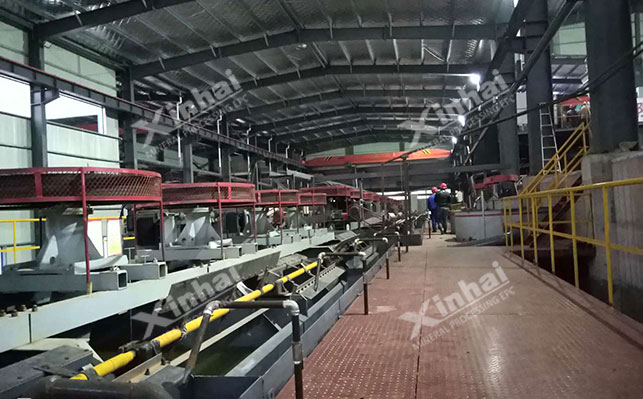
15311826613
Click to add WeChatMolybdenum is one of the non-renewable strategic mineral resources. It is used in steel, chemical industry, military, electronics, biomedicine, agriculture and other fields. There are more than 30 types of molybdenum ores known so far. However, due to long-term mining, easy-to-select and high-grade molybdenum are gradually decreasing. Nowadays, difficult-to-select molybdenum is the main mining type. The following article focuses on the difficult-to-select molybdenum ore dressing scheme. Before introducing the dressing scheme, let's first understand what types of difficult-to-select molybdenum ores are there?

The main difficult-to-select molybdenum ores in my country generally include: high oxidation rate type molybdenum ore, talc-containing molybdenum ore or talc-containing copper-molybdenum ore, carbon-containing, carbonaceous shale and organic molybdenum-carbon type molybdenum ore or polymetallic, impregnated fine or ultrafine type molybdenum ore, and complex structure type molybdenum ore, etc. Most of these difficult-to-select molybdenum ores contain more than 0.08% molybdenum, which exceeds the industrial grade of molybdenum. Some molybdenum ores contain more than 0.1% molybdenum, and are also accompanied by valuable metals such as lead, gold, and silver, which have certain development value and comprehensive utilization value.
Talc-type molybdenum ores contain a certain amount of talc, and the floatability of the two minerals is very similar. The two are called "equally floatable minerals", and their selectability is obviously difficult.

At present, there are magnetic separation-classification-mud and sand separation-new reagents to inhibit talc and select molybdenum ore; there is also the principle process of rough grinding-magnetic separation-magnetic tailings desludging-molybdenum rough selection-fine grinding-molybdenum selection, in which the reagents used are a mixture of CF23, CF24, and CF25, and the drugs are used to inhibit talc and obtain molybdenum concentrate.
High oxidation rate molybdenum ore is a molybdenum ore that has been partially oxidized in the upper part of the ore bed after the mineral has experienced wind erosion, rain and sunshine in a long geological period. The molybdenum sulfide is partially or mostly oxidized to molybdenum oxide or molybdate. Molybdenum oxide is naturally hydrophilic and has extremely low hydrophobicity. The crystallization is incomplete and mostly fine-grained. It is difficult to select. Many molybdenum deposits have oxidation zones of varying degrees in the upper part of up to hundreds of meters or as little as 10 meters.
For this type of molybdenum ore, water glass can be used as a mud dispersant and kerosene as a collector to float sulfide ore. Modified water glass can be used as a gangue inhibitor and RT as a collector for oxidized molybdenum ore to preferentially float sulfide ore and then float oxidized ore.
Nickel-molybdenum deposit is a paragenetic ore mainly composed of nickel and molybdenum and containing vanadium, uranium and a variety of rare and precious metals with recycling value. The main molybdenum mineral is colloidal molybdenite (MoS2), which is an amorphous molybdenum sulfide mineral. It will transform into hexagonal molybdenite after a little heating, while the nickel ore is mainly nickel disulfide, nickelite and arsenopyrite.

This type of molybdenum ore contains not only valuable metals Ni and Mo, but also rich platinum group metals and rare earth metals. It is a multi-metal complex ore. Because this ore contains a large amount of graphite. Although nickel and molybdenum exist in the form of sulfides, they coexist with pyrite in ultra-fine particles, and nickel and molybdenum cannot be separated by traditional beneficiation methods.
If this ore is used alone as a molybdenum ore, it will inevitably cause nickel loss. If it is used as a nickel ore, the high molybdenum content seriously affects the existing nickel metallurgical process. Due to the particularity of mineral morphology, the comprehensive recovery and beneficiation effects of molybdenum and nickel mineral resources are not ideal. The smelting currently remains in the process methods of electric furnace smelting molybdenum iron, roasting-leaching, high temperature oxygen pressure leaching, and normal temperature wet leaching, and they are all limited to minerals with a molybdenum grade of more than 2%, and at the same time cause serious pollution to the environment.
For nickel-molybdenum ore, the process flow of crushing ball milling-sodium hypochlorite decomposition-ion exchange-purification-crystallization-drying can be used to separate nickel and molybdenum. This method has a high metal recovery rate, a simple process, and good product quality.
The above mainly introduces the types of difficult-to-select molybdenum ores and the beneficiation methods of various difficult-to-select ores. In the actual beneficiation process, due to the different types of molybdenum ores, their difficulty in selection is also different. Therefore, it is recommended to conduct beneficiation test analysis, and then carry out targeted design of suitable molybdenum ore beneficiation process flow, which is the main method to effectively obtain molybdenum concentrate.